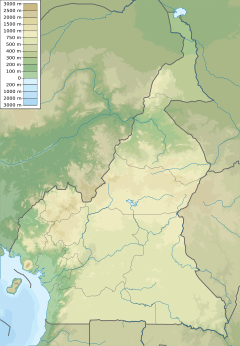Mount Oku caecilian facts for kids
Quick facts for kids Mount Oku caecilian |
|
|---|---|
| Conservation status | |
| Scientific classification | |
| Crotaphatrema lamottei is only known from Mount Oku, Cameroon | |
| Synonyms | |
|
Scolecomorphus lamottei Nussbaum, 1981 |
Crotaphatrema lamottei, also known as the Mount Oku caecilian or Lamotte's caecilian, is a unique type of caecilian. Caecilians are amphibians, like frogs and salamanders, but they look more like worms or snakes. This special caecilian belongs to the family Scolecomorphidae.
This animal is found only in one specific place: Mount Oku in Cameroon, Africa. When scientists find a species that lives only in one small area, they call it endemic to that place. The name lamottei was given to honor a French biologist named Maxime Lamotte. Scientists are still studying if another caecilian, Crotaphatrema tchabalmbaboensis, is truly a different species or if it's the same as the Mount Oku caecilian.
What Does the Mount Oku Caecilian Look Like?
These caecilians can vary in size. Male Mount Oku caecilians are usually between 14.3 and 28.1 centimeters (about 5.6 to 11 inches) long. Females are a bit larger, measuring from 26.2 to 32.5 centimeters (about 10.3 to 12.8 inches) in total length. Their bodies are quite slender, with a width between 0.5 and 1.15 centimeters (about 0.2 to 0.45 inches) around the middle.
They have many rings, called annuli, around their bodies, usually between 115 and 129 of them. These rings don't go all the way around on their underside. You won't see any eyes on these caecilians from the outside. In nature, their backs are a mix of sienna brown and pale lilac colors. Their bellies are a creamy white. The sides of their upper jaws and the areas around their special sensory tentacles are also cream-colored. The very tip of their snout is a tan-brown.
Where Do Mount Oku Caecilians Live?
The Mount Oku caecilian lives in different types of environments around Mount Oku. You can find them in secondary forests, which are forests that have grown back after being cut down. They also live at the edges of forests and even in farmland. However, they always stay close to the forest, never more than 500 meters (about 1,640 feet) away. They prefer to live at high altitudes, around 2,300 meters (about 7,500 feet) above sea level.
Scientists believe these caecilians lay eggs, which means they are oviparous. Unlike some amphibians, they don't seem to need bodies of water like ponds or streams for their reproduction.
Protecting the Mount Oku Caecilian
The Mount Oku caecilian does not have a very large population, and it lives in a very specific area. Its exact home range is still being mapped by scientists. The natural places where these caecilians live are threatened by human activities. These include farming, animals grazing, fires, and forests being broken up into smaller pieces. It's not fully known how these changes affect the Mount Oku caecilian specifically.
Sometimes, local people might accidentally kill these caecilians. This might happen because they look a bit like snakes, and people might confuse them. Good news is that some parts of the habitat on Mount Oku are protected, which helps keep these unique amphibians safe.



